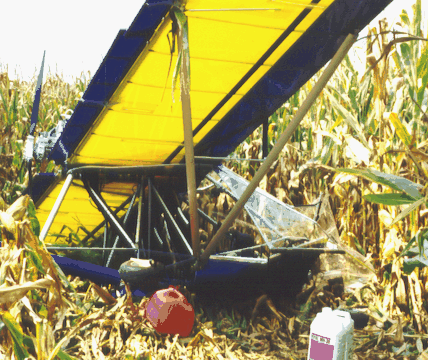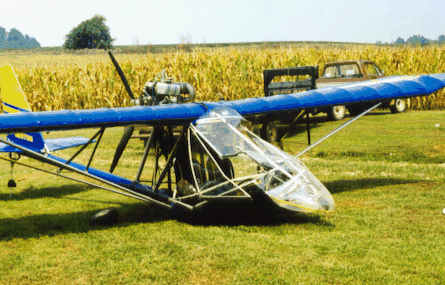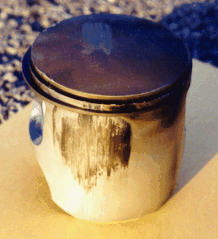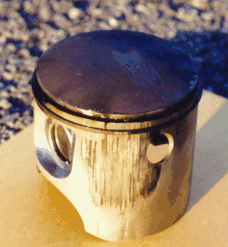This is a site that I really
wish I never had to create. I am hoping by telling everyone about this
will help to keep it from happening to others. I did not get hurt.
This is a list of what
will be on this site:
 What led up to the crash?
What led up to the crash?
 When the Engine Quit!
When the Engine Quit!
 What caused
the engine to quit?
What caused
the engine to quit?
 What
could have been done to keep this from happening?
What
could have been done to keep this from happening?
 How much damage?
How much damage?
What led up to the
crash?
September 1, 1997 - I had 28
hours on my Rans S12xl, Rotax 582. Both the aircraft and engine had been
performing perfectly. Not any problems at all. I did my preflight,
insured that the oil tank and fuel tanks were full then started my
aircraft and taxied to the runway. I did a engine
run-up and checked both
set of plugs. Everything checked out good. The taxi and run-up was about
3 - 5 minutes. I took to the runway and climbed to about 1500 - 2000 ft.
I flew toward my brother-in-laws farm about a 10 - 15 minute flight.
When I got near his farm I throttled back to idle (2000 rpm) and
descended to about 600 ft. I had built up a little extra speed as I
leveled off and waved at his wife. I put my hand back beside the
throttle I was about to start a left hand turn when I heard the engine
idle back further. I started to increase the throttle slowly, but the
engine continued to lose power till it quit.
I did a engine
run-up and checked both
set of plugs. Everything checked out good. The taxi and run-up was about
3 - 5 minutes. I took to the runway and climbed to about 1500 - 2000 ft.
I flew toward my brother-in-laws farm about a 10 - 15 minute flight.
When I got near his farm I throttled back to idle (2000 rpm) and
descended to about 600 ft. I had built up a little extra speed as I
leveled off and waved at his wife. I put my hand back beside the
throttle I was about to start a left hand turn when I heard the engine
idle back further. I started to increase the throttle slowly, but the
engine continued to lose power till it quit.
When the Engine Quit!
Shock! After a short moment of
shock, my first instinct was to restart the engine. Before I could move
my hand to the starter I thought about the area I was in. I had flown
over this area a lot and knew that the area in front of me had trees and
possibly fences and power lines, directly behind me was a corn field
without any other obstructions. There was even a dirt road back a little
ways, at first I thought I could make it to that
 road. I started a left
hand turn. Things were happening too fast. I did not get time to look at
my instruments. I got the plane turned around, but in the process I loss
a lot of airspeed and altitude. I knew I loss a lot of airspeed because
when I pulled the stick to the right to level the wings nothing
happened, I was in a stall. I moved the stick back to the left and then
back to the right and held it there. I had done spins and wing overs
before and knew that I had to push right rudder, but before I could make
my foot move, I heard the corn stalks and I hit the ground in a nose
down attitude. It was quit a jolt, but I had a shoulder strap and a seat
belt on. I didn't get hurt, but I believe that if I had a passenger they
would have. It seems that the plane did finally turn toward the right
just before impact. I realized that I was ok. I looked at the crumpled
passenger side and then out at the pilot side wing tip on the ground. I
was even with the ground and knew that the gear were folded up. I heard
my brother-in-laws wife yelling for me and I yelled back that I was ok.
We drained the fuel out of the tanks. My brother-in-law showed up and
had some guys with him, they were getting ready to cut his tobacco. We
all grabbed hold of the airplane and carried it out of the corn. I know
I was coming down at a steep angle because I did not knock down much
more corn than what you see in the picture.
road. I started a left
hand turn. Things were happening too fast. I did not get time to look at
my instruments. I got the plane turned around, but in the process I loss
a lot of airspeed and altitude. I knew I loss a lot of airspeed because
when I pulled the stick to the right to level the wings nothing
happened, I was in a stall. I moved the stick back to the left and then
back to the right and held it there. I had done spins and wing overs
before and knew that I had to push right rudder, but before I could make
my foot move, I heard the corn stalks and I hit the ground in a nose
down attitude. It was quit a jolt, but I had a shoulder strap and a seat
belt on. I didn't get hurt, but I believe that if I had a passenger they
would have. It seems that the plane did finally turn toward the right
just before impact. I realized that I was ok. I looked at the crumpled
passenger side and then out at the pilot side wing tip on the ground. I
was even with the ground and knew that the gear were folded up. I heard
my brother-in-laws wife yelling for me and I yelled back that I was ok.
We drained the fuel out of the tanks. My brother-in-law showed up and
had some guys with him, they were getting ready to cut his tobacco. We
all grabbed hold of the airplane and carried it out of the corn. I know
I was coming down at a steep angle because I did not knock down much
more corn than what you see in the picture.
What caused the
engine to quit? -
In short: Cold
Seizure - Cylinder cooled too fast for piston.
At first I
thought it was either fuel starvation or something electrical that
shorted out. I checked everything I could think of, I took the carbs
apart, I checked all the fuel lines, I checked all the wiring, no luck.
I then took off the muffler to looked inside the engine cylinders at the
pistons, there it was the rear piston was scored. The Rotax 582 is a
liquid cooled engine and ships without a thermostat. Rotax does make a
thermostat for this engine but it is not installed on a new engine.
While descending with the engine at idle it appears that the engines rear
cylinder cooled faster than the piston and caused it to seize.
What could have been
done to keep this from happening? -
In short: A
thermostat and idling back to 3000 rpm rather than 2000 except for
final approach.
I called two
different Rotax engine repairman and explained the what led up to the
engine quitting.
The first question both of them asked me was if the engine had a
thermostat installed on it. At the time I was not sure because the
pictures I had seen in
showed a thermostat. When I told them that the engine was new, they told
me that if I had not installed a thermostat, then the engine did not
have one. They said that if the engine had a thermostat install, it
would have kept the hot water around the cylinder during the decent and
then the cylinder would not have cooled off too fast, therefore the
piston would not have seized. They also said not to leave the engine at
idle for a long period, periodically rev the engine during long idle times
while flying, as in long decents. I asked about warranty coverage and
was told that Rotax will not pay for any type of seizures unless it was
caused by something in the engine that malfunctioned. They said that
Rotax claims that seizures are caused by something that the operator did
wrong.
How much damage? -
About $350 for
the engine repair (one new piston, cylinder wall cleaned, and a
thermostat installed). All the parts to repair the aircraft $3500. New
paint and clear coat about $500. The total should be between $4000 -
$5000.
Final thoughts -
The main thing
that I cannot understand is why does Rotax not install a
thermostat on their liquid cooled engines? Why would you not want a
thermostat? If anyone out there has had this same type of problem,
please send me e-mail. You might be able to let me know something else to
lookout for. I hope that what I have done will keep this from happening
again. One other thing that I noticed was the amount of carbon on the
pistons after only 28 hours. I was using Texaco Havoline 2 stroke oil
but will be switching to Pennzoil 2 stroke for air cooled engines. I
have read and been told that this is the best oil for Rotax engines air
or liquid cooled. I am in the process of rebuilding now (March 21,1998)
and hope to be flying again by May. I hope to get allot more than 28
hours of flying in this year!
May 9,1998 All work is done and I'm flying again. I now have a
thermostat and I run the engine up before every flight until the water
temp has started to come up. I can feel the radiator hoses and when they
get warm I'm good to go!
May 24,1998 Over 44 hours and all is well!
I had piston scoring during a 100 hr inspection and switched to Havoline
outboard oil. I have been checking the pistons every 25 hr. I have found
that on a Rans S12xl with a 582 that the bottom rings will stick after
75 hrs.. I have discussed this with one other pilot with the same setup
and we both have the same conditions and in the same area. There is not
a lot of carbon but the bottom ring will stick after 75 hrs and needs to
be removed and the groove cleaned good.
The above can be found at:
http://www.geocities.com/hester-hoptown/CrashSite/Crash.html


 I did a engine
run-up and checked both
set of plugs. Everything checked out good. The taxi and run-up was about
3 - 5 minutes. I took to the runway and climbed to about 1500 - 2000 ft.
I flew toward my brother-in-laws farm about a 10 - 15 minute flight.
When I got near his farm I throttled back to idle (2000 rpm) and
descended to about 600 ft. I had built up a little extra speed as I
leveled off and waved at his wife. I put my hand back beside the
throttle I was about to start a left hand turn when I heard the engine
idle back further. I started to increase the throttle slowly, but the
engine continued to lose power till it quit.
I did a engine
run-up and checked both
set of plugs. Everything checked out good. The taxi and run-up was about
3 - 5 minutes. I took to the runway and climbed to about 1500 - 2000 ft.
I flew toward my brother-in-laws farm about a 10 - 15 minute flight.
When I got near his farm I throttled back to idle (2000 rpm) and
descended to about 600 ft. I had built up a little extra speed as I
leveled off and waved at his wife. I put my hand back beside the
throttle I was about to start a left hand turn when I heard the engine
idle back further. I started to increase the throttle slowly, but the
engine continued to lose power till it quit.
 road. I started a left
hand turn. Things were happening too fast. I did not get time to look at
my instruments. I got the plane turned around, but in the process I loss
a lot of airspeed and altitude. I knew I loss a lot of airspeed because
when I pulled the stick to the right to level the wings nothing
happened, I was in a stall. I moved the stick back to the left and then
back to the right and held it there. I had done spins and wing overs
before and knew that I had to push right rudder, but before I could make
my foot move, I heard the corn stalks and I hit the ground in a nose
down attitude. It was quit a jolt, but I had a shoulder strap and a seat
belt on. I didn't get hurt, but I believe that if I had a passenger they
would have. It seems that the plane did finally turn toward the right
just before impact. I realized that I was ok. I looked at the crumpled
passenger side and then out at the pilot side wing tip on the ground. I
was even with the ground and knew that the gear were folded up. I heard
my brother-in-laws wife yelling for me and I yelled back that I was ok.
We drained the fuel out of the tanks. My brother-in-law showed up and
had some guys with him, they were getting ready to cut his tobacco. We
all grabbed hold of the airplane and carried it out of the corn. I know
I was coming down at a steep angle because I did not knock down much
more corn than what you see in the picture.
road. I started a left
hand turn. Things were happening too fast. I did not get time to look at
my instruments. I got the plane turned around, but in the process I loss
a lot of airspeed and altitude. I knew I loss a lot of airspeed because
when I pulled the stick to the right to level the wings nothing
happened, I was in a stall. I moved the stick back to the left and then
back to the right and held it there. I had done spins and wing overs
before and knew that I had to push right rudder, but before I could make
my foot move, I heard the corn stalks and I hit the ground in a nose
down attitude. It was quit a jolt, but I had a shoulder strap and a seat
belt on. I didn't get hurt, but I believe that if I had a passenger they
would have. It seems that the plane did finally turn toward the right
just before impact. I realized that I was ok. I looked at the crumpled
passenger side and then out at the pilot side wing tip on the ground. I
was even with the ground and knew that the gear were folded up. I heard
my brother-in-laws wife yelling for me and I yelled back that I was ok.
We drained the fuel out of the tanks. My brother-in-law showed up and
had some guys with him, they were getting ready to cut his tobacco. We
all grabbed hold of the airplane and carried it out of the corn. I know
I was coming down at a steep angle because I did not knock down much
more corn than what you see in the picture.

